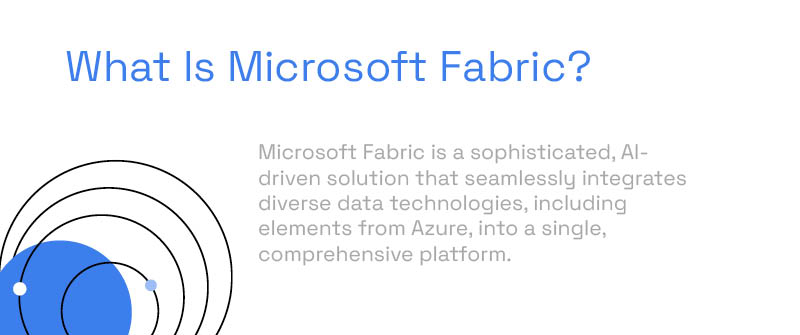
Since its launch in 2023, Microsoft Fabric has quickly become a cornerstone platform for organizations navigating today’s rapidly evolving data landscape.
Fabric offers a unified, cloud-native solution for managing, analyzing, and operationalizing massive volumes of data with unprecedented speed and flexibility. Seamlessly integrated across the Microsoft ecosystem—including Azure and Power BI—Fabric empowers businesses to unlock real-time analytics, build AI/ML pipelines, and drive intelligent decision-making at scale.
Whether you’re evaluating Microsoft Fabric Data Analytics for its cutting-edge technology or considering Microsoft Fabric certification to bolster your expertise, this guide is designed to equip you with a comprehensive understanding of what makes Microsoft Fabric a game-changer in modern data management.

What Is Microsoft Fabric?
Microsoft Fabric is an end-to-end AI, SaaS-based data and analytics platform built to simplify and accelerate the journey from raw data to actionable insights.
By offering a unified experience across data movement, storage, processing, governance, and analytics, Fabric eliminates the need for patchwork solutions and siloed tools.
Fabric is built to serve a wide range of workloads—real-time analytics, business intelligence, machine learning, and large-scale data processing—through a single, cohesive architecture.
Key pillars of Microsoft Fabric:
- Lakehouses and Warehouses: Support for both structured and semi-structured data.
- OneLake: A single, unified data lake storage layer accessible to all services.
- Direct Lake mode for Power BI: Real-time, fast query access to massive datasets.
- Built-in Data Activator: Low-code automation for real-time monitoring and action.
- Integrated AI capabilities: Native support for ML model development, training, and deployment.
Core Features of Microsoft Fabric
Here’s a closer look at the key components that power Microsoft Fabric:
1. OneLake
Fabric’s universal data lake storage layer, designed for:
- Single copy of data across all analytics services
- Simplified governance and security
- Seamless collaboration across teams
2. Data Factory Integration
A unified data ingestion and transformation experience:
- Drag-and-drop data pipeline creation
- Built-in data flows and connectors
- Orchestration across hybrid and multi-cloud environments
3. Synapse Data Engineering
Powerful big data processing with Spark:
- Large-scale ETL and data prep
- Native Spark environment embedded within Fabric
- Serverless or provisioned compute options
4. Real-Time Analytics
High-speed ingestion and querying of streaming data:
- Analyze IoT device telemetry
- Financial transaction monitoring
- User behavior event streaming
5. Power BI Direct Lake Mode
Optimized access to OneLake-stored data:
- Near real-time dashboards
- Eliminates need for dataset refreshes
- Massively scalable, low-latency querying
6. Data Activator
Fabric’s real-time event detection and automated response service:
Alerts and automatic workflows based on data changes
No-code and low-code triggers
Tools and Services Microsoft Fabric Integrates With
Microsoft Fabric is designed to work seamlessly within the larger Microsoft data and cloud ecosystem, including:
- Microsoft 365 Applications: Embedding insights into productivity tools like Teams, Outlook, and Excel.
- Azure Data Lake Storage: Integration through OneLake and Azure connectors.
- Power BI: Deep, real-time analytics directly layered onto Fabric’s storage. Learn more about Microsoft Fabric vs Power BI.
- Microsoft Purview: Governance, data lineage, and compliance management.
- Azure Synapse Analytics: Migration pathways and parallel processing options.
- Azure Machine Learning: Building, training, and deploying ML models at scale.
What Is Microsoft Fabric Used For?
Microsoft Fabric excels at next-generation analytics solutions requiring massive, near real-time data ingestion, complex querying, and machine learning at the cloud scale.
Top use cases set to benefit include:
Real-Time Analytics
- Process and analyze IoT device data streams for monitoring, alerting, or dynamic optimization.
- Powering financial threat detection, algorithmic trading, or risk models.
- Enabling dynamic personalization and decisions across digital channels.
AI/MLOps
- Distributed model development, training, and deployment lifecycle.
- Powering recommendation and search relevance machine learning pipelines.
- Optimizing manufacturing or supply chain operations via AI.
Hybrid Transaction/Analytical Processing
- Ingesting and querying high-velocity event data for profile building, attribution, and reporting.
- Backing SaaS, gaming, or retail apps requires immense concurrency and throughput.
Essentially, any project dealing with lots of fast-moving data necessitating complex analytics, decisions, or insights in milliseconds stands to benefit hugely from Fabric’s native cloud architecture.
How Long Does It Take to Learn Microsoft Fabric?
For experienced data professionals, ramp-up time to productively leverage Microsoft Fabric is estimated at around 3-5 weeks, assuming existing Azure fluency. This accounts for absorbing key architectural concepts, new terminology, API exploration, and mapping use cases to Fabric’s specialized dataset offerings.
Less seasoned data engineers or those newer to Azure should budget 6-8 weeks before achieving proficiency. Grasping foundational big data, analytics, and cloud fundamentals takes legwork that pays dividends when applying Fabric appropriately.
Either way, Microsoft Fabric’s managed nature combined with purpose-built data structures and tooling accelerates hitting the ground running compared to configuring open-source data platforms.
Learning Microsoft Fabric: Certification and Resources
The Microsoft Fabric Analytics Engineer Associate certification is available, validating skills in:
- Designing and building scalable analytics solutions
- Integrating Fabric with Power BI
- Operating, monitoring, and optimizing Fabric workloads
- Managing lakehouses, dataflows, and semantic models
Recommended learning paths:
- Microsoft Learn Fabric Training (free modules)
- Beta exam resources and sample questions (official Microsoft site)
- Hands-on practice: Set up Fabric environments and simulate real-world use cases.
Certification candidates are typically data analysts, engineers, or architects aiming to expand into Fabric-based analytics engineering roles.
Learn more about Microsoft Fabric vs Power BI.
Feedback and Updates: Shaping the Future of Microsoft Fabric
Microsoft Fabric Data Analytics is not just a product but a growing ecosystem, evolving through user experiences, feedback, and the ever-changing demands of the data analytics landscape. Microsoft is committed to making Fabric not only meet but exceed user expectations, and community feedback is a cornerstone of this process. Engaging with users, understanding their challenges, and incorporating their insights are key steps in the continuous improvement of Microsoft Fabric.
Staying Updated with Microsoft Fabric
Keeping abreast of the latest Microsoft Fabric news and updates is essential for maximizing the platform’s potential. Microsoft provides a variety of channels for users to stay informed:
- Fabric Documentation Hub: A comprehensive resource for all things Fabric, from Microsoft Fabric tutorials and guides to detailed documentation on new features.
- Azure Updates: Regular updates on Azure services, including Fabric, offering insights into new capabilities, bug fixes, and performance enhancements.
- Community Forums and Blogs: Active discussions and blogs by both Microsoft professionals and community experts provide real-world insights, tips, and announcements related to Fabric.
Providing Feedback
Microsoft encourages Fabric users to share their experiences and suggestions through several avenues:
- User Voice: A platform where you can submit ideas, vote on existing suggestions, and engage with the Fabric product team.
- GitHub Issues: For developers integrating or building on Fabric, reporting issues or suggestions through GitHub connects you directly with Microsoft engineers.
- Direct Support Channels: Enterprise users have access to dedicated support channels where feedback can be more detailed and use-case-specific.
Participating in the Fabric Community
Joining the Microsoft Fabric community is a great way to contribute to the platform’s evolution, network with peers, and learn from the collective experiences of a global user base. Community participation can take various forms:
- Beta Testing and Early Adopter Programs: Get early access to new features, providing valuable feedback that shapes the final release.
- Community Events and Webinars: Engage with experts and fellow users in interactive sessions focused on best practices, new features, and innovative uses of Microsoft Fabric.
- Social Media and Forums: Platforms like LinkedIn, Reddit, and the official Azure forum offer vibrant spaces for discussion, knowledge exchange, and staying updated on everything related to Microsoft Fabric.
Ready to Get Started?
Ready to get started with Microsoft Fabric for your organization’s data program? Our expert Microsoft Fabric consultants can help guide your Fabric adoption strategy and implementation.
With deep knowledge across the Microsoft data and analytics stack, including past hands-on Fabric preview experience, our team brings practical insights into how Fabric can transform your analytics workflows, decisions, and business vision.
We take a collaborative, best practice-driven approach to assessing current challenges and future objectives before architecting an optimal path to leverage Fabric capabilities tailored specifically for your use case when the time comes.
Reach out today to start a conversation and learn more about our Microsoft Fabric early adopter program, helping enterprises, startups, and public sector organizations hit the ground running with Fabric for maximum ROI.
Get in touch with a P3 team member